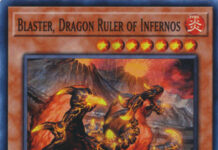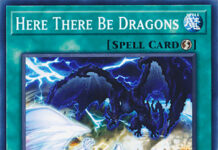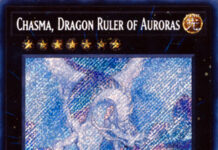The year of 2018 is now over, so let’s look back at some more of the best cards of the year. Hello Pojo Readers, Crunch$G back here again with another article. As you saw already, we recently did the Top 11 Yu-Gi-Oh cards of the year and we all know what made the list and what didn’t, however; there are still many cards that deserve a mention at least because every year has more than 10 really good cards. A lot of them fall into groups this year, though, so for simplicity I’ll group the cards as I see fit. Some might not be on the power level as others, but they are good enough to warrant some mention of some sort. With that out of the way, let’s discuss some of the other best cards in 2018.
Mekk-Knights
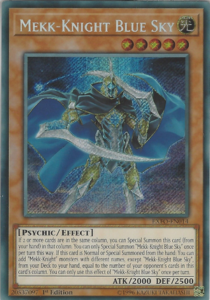 I’ll start off with one of the first groups, the Mekk-Knight archetype as a whole. The monsters in the archetype have an easy summoning condition of just being summoned to any column where 2 or more cards are already on the field. The best cards in the archetype are probably the two searchers they have: Blue Sky, which searches for cards equal to the number of cards your opponent controls in the same column as it when summoned from the hand, as well as Purple Nightfall, which banishes a Mekk-Knight once per turn during either players turn to get you to any Mekk-Knight. Indigo Eclipse is pretty good as well as it can move any Mekk-Knight you control to a different column so you can summon another Mekk-Knight from the hand. There are also a few more decent Mekk-Knight main deck monsters like Red Moon to banish a Mekk-
I’ll start off with one of the first groups, the Mekk-Knight archetype as a whole. The monsters in the archetype have an easy summoning condition of just being summoned to any column where 2 or more cards are already on the field. The best cards in the archetype are probably the two searchers they have: Blue Sky, which searches for cards equal to the number of cards your opponent controls in the same column as it when summoned from the hand, as well as Purple Nightfall, which banishes a Mekk-Knight once per turn during either players turn to get you to any Mekk-Knight. Indigo Eclipse is pretty good as well as it can move any Mekk-Knight you control to a different column so you can summon another Mekk-Knight from the hand. There are also a few more decent Mekk-Knight main deck monsters like Red Moon to banish a Mekk-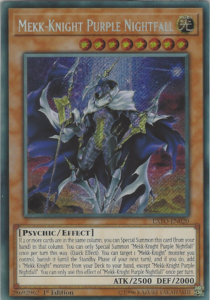 Knight to destroy an opponent’s face-up monster in the same column as it, and Yellow Star which is similar to Red Moon only for any Spell/Trap in its column. The Link-2 of the archetype gives your Mekk-Knights battle destruction protection from monsters in different columns and lets you discard a Mekk-Knight or World Legacy card to search for any World Legacy card, which some work with the archetype. They have several Continuous Spells and Traps that negate Monster, Spell, or Trap effects if they are activated in the same column as a Mekk-Knight along with having other various effects as well as they have a Field Spell that lets you discard a Mekk-Knight to draw 1 card and if you somehow pull it off, you can banish 8 Mekk-Knights with different names from your field or GY to send your opponent’s hand and Extra Deck to the GY. The final World Legacy card for them is a Quick-Play Spell that summons any Mekk-Knight from the deck, but it goes back to your hand at the end of the turn and you are locked to Mekk-Knight Special Summons. The archetype is well rounded with great cards to make for a pure deck or to be splashed into other decks. It is up there as being one of the better World Legacy archetypes.
Knight to destroy an opponent’s face-up monster in the same column as it, and Yellow Star which is similar to Red Moon only for any Spell/Trap in its column. The Link-2 of the archetype gives your Mekk-Knights battle destruction protection from monsters in different columns and lets you discard a Mekk-Knight or World Legacy card to search for any World Legacy card, which some work with the archetype. They have several Continuous Spells and Traps that negate Monster, Spell, or Trap effects if they are activated in the same column as a Mekk-Knight along with having other various effects as well as they have a Field Spell that lets you discard a Mekk-Knight to draw 1 card and if you somehow pull it off, you can banish 8 Mekk-Knights with different names from your field or GY to send your opponent’s hand and Extra Deck to the GY. The final World Legacy card for them is a Quick-Play Spell that summons any Mekk-Knight from the deck, but it goes back to your hand at the end of the turn and you are locked to Mekk-Knight Special Summons. The archetype is well rounded with great cards to make for a pure deck or to be splashed into other decks. It is up there as being one of the better World Legacy archetypes.
Mythical Beast Master Cerberus and Jackal King
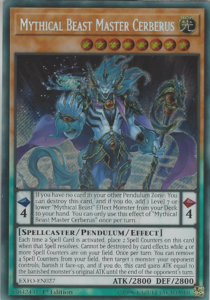 These two go together well since they do make up for a good engine for some Pendulum decks. Master Cerberus in the Pendulum Scale lets him pop himself, just as long as you have no other card in your other Scale, to search for any Level 7 or lower Mythical Beast Pendulum, which Jackal King is. Master Cerberus also places 2 Spell Counters on himself when a Spell activates and resolves, gets protection if it has 4 Counters, and can remove 4 Counters from the field to banish an opponent’s monster face-up and gain its ATK til the end of your opponent’s turn. The other Mythical Beast is Jackal King, which in the Scale can pop itself, with the same
These two go together well since they do make up for a good engine for some Pendulum decks. Master Cerberus in the Pendulum Scale lets him pop himself, just as long as you have no other card in your other Scale, to search for any Level 7 or lower Mythical Beast Pendulum, which Jackal King is. Master Cerberus also places 2 Spell Counters on himself when a Spell activates and resolves, gets protection if it has 4 Counters, and can remove 4 Counters from the field to banish an opponent’s monster face-up and gain its ATK til the end of your opponent’s turn. The other Mythical Beast is Jackal King, which in the Scale can pop itself, with the same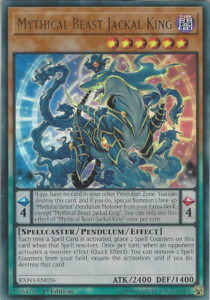 restriction as previously, to summon any Mythical Beast Pendulum from face-up in your Extra Deck that isn’t another Jackal King, so the obvious one is Master Cerberus if you aren’t playing pure Mythical Beasts. Jackal King is better as a monster on the field than Master Cerberus, as it gains 2 Spell Counters as well when a Spell activates and resolves, but can remove 2 Counters during either player’s turn to negate a monster effect. So basically you can use Master Cerberus to search Jackal King, then use Jackal King to get back to Master Cerberus, then use the Master Cerberus for a Link Summon for something like Electrumite, then finally Pendulum Summon the Jackal King and activate a Spell or hope your opponent does for some easy negation. It is a pretty decent engine in Pendulum decks, especially Pendulum Magician, and deserves a mention even though they probably would of never made the Top 11 unless we put groups of cards together.
restriction as previously, to summon any Mythical Beast Pendulum from face-up in your Extra Deck that isn’t another Jackal King, so the obvious one is Master Cerberus if you aren’t playing pure Mythical Beasts. Jackal King is better as a monster on the field than Master Cerberus, as it gains 2 Spell Counters as well when a Spell activates and resolves, but can remove 2 Counters during either player’s turn to negate a monster effect. So basically you can use Master Cerberus to search Jackal King, then use Jackal King to get back to Master Cerberus, then use the Master Cerberus for a Link Summon for something like Electrumite, then finally Pendulum Summon the Jackal King and activate a Spell or hope your opponent does for some easy negation. It is a pretty decent engine in Pendulum decks, especially Pendulum Magician, and deserves a mention even though they probably would of never made the Top 11 unless we put groups of cards together.
Inspector Boarder
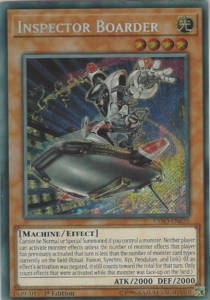 The first card to get its own entry, as it doesn’t really have to work with other cards. Inspector Boarder is a Level 4 with 2000 ATK and DEF that cannot be Normal/Special Summoned if you control a monster. To make up for that, however, while it is face-up on the field, each player can only activate monster effects up to the number of certain monster card types there are on the field (which are Ritual, Fusion, Synchro, Xyz, Pendulum, and Link). It only counts effects that were activated while this card was face-up, but at the same time it also counts effects that were negated. Inspector Boarder is a powerful Normal Summon in many different stun decks and can really slow or stop your opponent from playing the game. One of the best stun cards in the game, especially in a deck like True Draco.
The first card to get its own entry, as it doesn’t really have to work with other cards. Inspector Boarder is a Level 4 with 2000 ATK and DEF that cannot be Normal/Special Summoned if you control a monster. To make up for that, however, while it is face-up on the field, each player can only activate monster effects up to the number of certain monster card types there are on the field (which are Ritual, Fusion, Synchro, Xyz, Pendulum, and Link). It only counts effects that were activated while this card was face-up, but at the same time it also counts effects that were negated. Inspector Boarder is a powerful Normal Summon in many different stun decks and can really slow or stop your opponent from playing the game. One of the best stun cards in the game, especially in a deck like True Draco.
Overtex Qoatlus
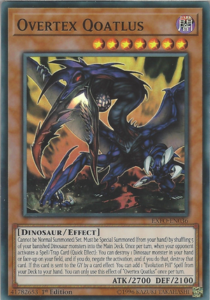 A card that helped Dinosaurs thrive after being hit on the F/L List, Overtex Qoatlus helps Dinosaurs as a whole somewhat better since it helps search for one of their best cards. First, I’ll mention Qoatlus must be summoned by shuffling 5 banished Dinosaurs back into your deck, which isn’t impossible but likely isn’t happening. It also negates a Spell/Trap from the opponent once per turn by destroying a Dinosaur in your hand or on your field to help trigger your baby Dinos. The final effect is what helped this see play as when it is sent to the GY by any means, you can add 1 Evolution Pill card from your deck to your hand, and the obvious one is Double Evolution Pill, as it is arguably the only good one as well. You can summon your Souleating Oviraptor and use its effect to send Overtex to the GY to search for your Double Evolution Pill, and you already got the Dinosaur fuel to use your Double Evolution Pill, or you can use Double Evolution Pill to summon Qoatlus if you don’t need Ultimate Conductor Tyranno and have some Spell/Trap negation. It might be really the only Dinosaur support this year, beyond the Dinowrestlers giving them a small boost, but the deck really made it count.
A card that helped Dinosaurs thrive after being hit on the F/L List, Overtex Qoatlus helps Dinosaurs as a whole somewhat better since it helps search for one of their best cards. First, I’ll mention Qoatlus must be summoned by shuffling 5 banished Dinosaurs back into your deck, which isn’t impossible but likely isn’t happening. It also negates a Spell/Trap from the opponent once per turn by destroying a Dinosaur in your hand or on your field to help trigger your baby Dinos. The final effect is what helped this see play as when it is sent to the GY by any means, you can add 1 Evolution Pill card from your deck to your hand, and the obvious one is Double Evolution Pill, as it is arguably the only good one as well. You can summon your Souleating Oviraptor and use its effect to send Overtex to the GY to search for your Double Evolution Pill, and you already got the Dinosaur fuel to use your Double Evolution Pill, or you can use Double Evolution Pill to summon Qoatlus if you don’t need Ultimate Conductor Tyranno and have some Spell/Trap negation. It might be really the only Dinosaur support this year, beyond the Dinowrestlers giving them a small boost, but the deck really made it count.
Curious, the Lightsworn Dominion
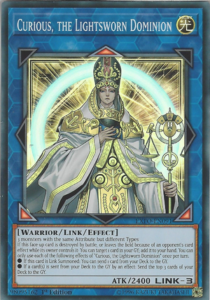 10 years after the debut of the archetype and they still get really good cards. Curious is a Link-3 that requires 3 monsters with the same attribute but different types, which the Lightsworn archetype can fulfill with ease, but so can other decks. If it is destroyed by battle or leaves the field while under your control because of your opponent, you can add back any card from your GY to your hand, meaning you can get back any power card, play enabler, or combo extender. Upon it’s Link Summon, you can send any card from your deck to the GY, which is an effect that got Lavalval Chain banned, so it was obviously going to be good on another card. It also milled the top 3 cards from your deck when a card was sent from your deck to the GY, so your typical Lightsworn card. Curious is a great Link Monster that’ll probably find uses for many years to come.
10 years after the debut of the archetype and they still get really good cards. Curious is a Link-3 that requires 3 monsters with the same attribute but different types, which the Lightsworn archetype can fulfill with ease, but so can other decks. If it is destroyed by battle or leaves the field while under your control because of your opponent, you can add back any card from your GY to your hand, meaning you can get back any power card, play enabler, or combo extender. Upon it’s Link Summon, you can send any card from your deck to the GY, which is an effect that got Lavalval Chain banned, so it was obviously going to be good on another card. It also milled the top 3 cards from your deck when a card was sent from your deck to the GY, so your typical Lightsworn card. Curious is a great Link Monster that’ll probably find uses for many years to come.
Gem-Knight Phantom Quartz
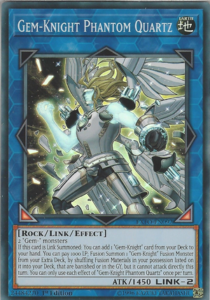 I mean, a card that helped cause an FTK that is able to top events has to warrant a mention, right? Gem-Knight Phantom Quartz is a Link-2 for the Gem-Knight archetype that has the simple summoning condition of two Gem- monsters, meaning you can use Gem-Armadillo, one of their best searchers. Phantom Quartz upon Link Summon searches for any Gem-Knight card and once per turn can let you pay 1000 LP to Fusion Summon a Gem-Knight monster using cards in your GY or that are banished for materials as long as it cannot attack directly. This still allowed you to use and abuse cards like Gem-Knight Lady Lapis Lazuli and Gem-Knight Master Diamond to achieve an FTK just as long as you Special Summon enough monsters. This FTK was good enough to get Master Diamond limited and the FTK still exists, it just isn’t as consistent since you have to make different plays to do the FTK. So yeah, you can’t really say Phantom Quartz didn’t make any impact.
I mean, a card that helped cause an FTK that is able to top events has to warrant a mention, right? Gem-Knight Phantom Quartz is a Link-2 for the Gem-Knight archetype that has the simple summoning condition of two Gem- monsters, meaning you can use Gem-Armadillo, one of their best searchers. Phantom Quartz upon Link Summon searches for any Gem-Knight card and once per turn can let you pay 1000 LP to Fusion Summon a Gem-Knight monster using cards in your GY or that are banished for materials as long as it cannot attack directly. This still allowed you to use and abuse cards like Gem-Knight Lady Lapis Lazuli and Gem-Knight Master Diamond to achieve an FTK just as long as you Special Summon enough monsters. This FTK was good enough to get Master Diamond limited and the FTK still exists, it just isn’t as consistent since you have to make different plays to do the FTK. So yeah, you can’t really say Phantom Quartz didn’t make any impact.
Altergeist Multifaker
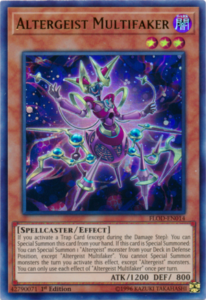 Altergeist had some meta potential before Multifaker, but after this card came out you start to notice the deck more often, and for good reason, Mutlifaker is an amazing card for the archetype. If you activate a Trap Card (except in the Damage Step like for many effects) you can Special Summon Multifaker from your hand, and just know Altergeist are known for running Traps in half of their deck. Upon the Special Summon of Multifaker, doesn’t have to be off its own effect, you can Special Summon an Altergeist from your deck in Defense Position as long as it isn’t another Multifaker, which might of not mattered when all the effects of Multifaker are hard once per turns. The card you summon off this the most is Altergeist Silquitous, who can bounce an Altergeist back to your hand along with an opponent’s monster, so this combos well with Multifaker so you can Special Summon it again when you use a Trap. Sure Multifaker will lock you to Altergeist summons, but that is mostly what you do in Altergeist. The card is so good the OCG limited it and I wouldn’t be completely surprised if the TCG ever followed up by doing the same. Multifaker really makes Altergeist the force that it is.
Altergeist had some meta potential before Multifaker, but after this card came out you start to notice the deck more often, and for good reason, Mutlifaker is an amazing card for the archetype. If you activate a Trap Card (except in the Damage Step like for many effects) you can Special Summon Multifaker from your hand, and just know Altergeist are known for running Traps in half of their deck. Upon the Special Summon of Multifaker, doesn’t have to be off its own effect, you can Special Summon an Altergeist from your deck in Defense Position as long as it isn’t another Multifaker, which might of not mattered when all the effects of Multifaker are hard once per turns. The card you summon off this the most is Altergeist Silquitous, who can bounce an Altergeist back to your hand along with an opponent’s monster, so this combos well with Multifaker so you can Special Summon it again when you use a Trap. Sure Multifaker will lock you to Altergeist summons, but that is mostly what you do in Altergeist. The card is so good the OCG limited it and I wouldn’t be completely surprised if the TCG ever followed up by doing the same. Multifaker really makes Altergeist the force that it is.
Cyber Dragons
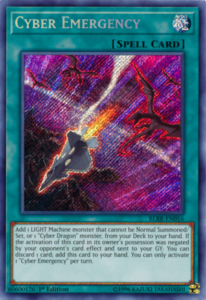 I’ve considered back and forth putting this archetype on this list, but considering it seemed like it was a pretty good rogue strategy this year, I thought I’d talk about some of the best cards from the Cyber Dragon support we got this year, mainly in Cybernetic Horizon. First off from Battles of Legend: Relentless Revenge was Cyber Emergency, a Normal Spell that searched for any LIGHT Machine monster that cannot be Normal Summoned or Set or searched for any Cyber Dragon monster. If the activation of the card in its owners possession was negated and sent to the GY, then you could discard a card to add it back to your hand so you can try and activate it again to search, meaning you didn’t really want to negate it unless it was via an Ash Blossom. Now for the Cybernetic Horizon support, Cyber Dragon Herz is another good Machine Duplication target for two Cyber Dragons and then when it is sent to your GY, you can get a Cyber
I’ve considered back and forth putting this archetype on this list, but considering it seemed like it was a pretty good rogue strategy this year, I thought I’d talk about some of the best cards from the Cyber Dragon support we got this year, mainly in Cybernetic Horizon. First off from Battles of Legend: Relentless Revenge was Cyber Emergency, a Normal Spell that searched for any LIGHT Machine monster that cannot be Normal Summoned or Set or searched for any Cyber Dragon monster. If the activation of the card in its owners possession was negated and sent to the GY, then you could discard a card to add it back to your hand so you can try and activate it again to search, meaning you didn’t really want to negate it unless it was via an Ash Blossom. Now for the Cybernetic Horizon support, Cyber Dragon Herz is another good Machine Duplication target for two Cyber Dragons and then when it is sent to your GY, you can get a Cyber 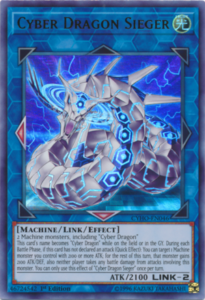 Dragon out of your deck or any of your monsters that are being treated as Cyber Dragon, including the original, from your GY. Cyber Dragon Sieger is a good Link-2 that can be summoned to the Extra Monster Zone or Main Monster Zone whether via Link Summon or off Cyber Dragon Nova, as Sieger can boost your Machines with 2100 or more ATK by another 2100 for the turn, only Sieger can no longer do damage for the same turn. Cyber Revsystem is a good Cyber Dragon revival Spell that gives the revived monster effect destruction protection, and Cybernetic Overflow is a good Trap that can banish Cyber Dragons from your GY to destroy cards your opponent controls and searches for a Cyber Spell/Trap if it is destroyed by a card effect. They also got support in Legendary Duelists: White Dragon Abyss, with the most noteworthy card being Cyberload Fusion to use your Cyber Dragons on the field or banished to Fusion Summon something like Chimeratech Rampage Dragon or Cyber Twin Dragon for some big damage maybe, and it’s a Quick-Play so you can use it on your opponent’s turn so Rampage can destroy set Spells/Traps from your opponent that turn before they can be activated as well as get around the restriction of the Fusion Summoned monster only being able to attack for the turn.
Dragon out of your deck or any of your monsters that are being treated as Cyber Dragon, including the original, from your GY. Cyber Dragon Sieger is a good Link-2 that can be summoned to the Extra Monster Zone or Main Monster Zone whether via Link Summon or off Cyber Dragon Nova, as Sieger can boost your Machines with 2100 or more ATK by another 2100 for the turn, only Sieger can no longer do damage for the same turn. Cyber Revsystem is a good Cyber Dragon revival Spell that gives the revived monster effect destruction protection, and Cybernetic Overflow is a good Trap that can banish Cyber Dragons from your GY to destroy cards your opponent controls and searches for a Cyber Spell/Trap if it is destroyed by a card effect. They also got support in Legendary Duelists: White Dragon Abyss, with the most noteworthy card being Cyberload Fusion to use your Cyber Dragons on the field or banished to Fusion Summon something like Chimeratech Rampage Dragon or Cyber Twin Dragon for some big damage maybe, and it’s a Quick-Play so you can use it on your opponent’s turn so Rampage can destroy set Spells/Traps from your opponent that turn before they can be activated as well as get around the restriction of the Fusion Summoned monster only being able to attack for the turn.
Knightmares
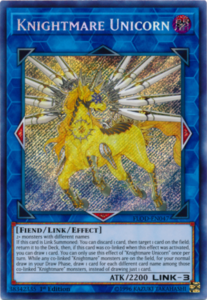 Knightmare Goblin did make the Top 11 list, so I won’t talk about it here, but the other Knightmare monsters are really good. All of them have the discard for a various effect and draw if it was co-linked, so that won’t be mentioned as much. Knightmare Mermaid let you summon a Knightmare from your deck and reduced all monsters that weren’t co-linked by 1000 ATK. The Knightmare you summoned was Corruptor Iblee, who when used for a Link Summon will go to your opponent’s field to lock them from Special Summon except via Link Summoning, which is hard to do when they are Extra Linked. Knightmare Phoenix destroys a Spell/Trap and gives your co-linked monsters protection from battle destruction. Knightmare Cerberus destroys a Special Summoned monster in the Main Monster Zone and gives co-linked monsters protection from destruction effects. Unicorn sends a card back to the deck and lets you draw cards during your Draw Phase up to the number of co-linked Knightmares you control. Finally, Gryphon lets you set a Spell/Trap in your GY for a future turn and prevents Special Summoned monsters from using effects unless they are linked. They are all very good cards and will get more Main Deck monsters, but none will be as good as Iblee. The Knightmares are seen in many Extra Linking combos due to the protection and other effects they offer along with removal, combo extension, and setup for future plays. They are the best Link Monsters we got.
Knightmare Goblin did make the Top 11 list, so I won’t talk about it here, but the other Knightmare monsters are really good. All of them have the discard for a various effect and draw if it was co-linked, so that won’t be mentioned as much. Knightmare Mermaid let you summon a Knightmare from your deck and reduced all monsters that weren’t co-linked by 1000 ATK. The Knightmare you summoned was Corruptor Iblee, who when used for a Link Summon will go to your opponent’s field to lock them from Special Summon except via Link Summoning, which is hard to do when they are Extra Linked. Knightmare Phoenix destroys a Spell/Trap and gives your co-linked monsters protection from battle destruction. Knightmare Cerberus destroys a Special Summoned monster in the Main Monster Zone and gives co-linked monsters protection from destruction effects. Unicorn sends a card back to the deck and lets you draw cards during your Draw Phase up to the number of co-linked Knightmares you control. Finally, Gryphon lets you set a Spell/Trap in your GY for a future turn and prevents Special Summoned monsters from using effects unless they are linked. They are all very good cards and will get more Main Deck monsters, but none will be as good as Iblee. The Knightmares are seen in many Extra Linking combos due to the protection and other effects they offer along with removal, combo extension, and setup for future plays. They are the best Link Monsters we got.
Ghost Belle & Haunted Mansion
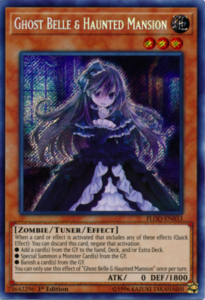 Last year, Ash Blossom made the number 1 spot for best cards of 2017, and I feel Ghost Belle just missed the list due to not being as useful as Ash Blossom and the power of all the cards we’ve seen released this year. Ghost Belle negates effects just like Ash Blossom, only with the GY. When your opponent activates an effect that would add a card from the GY to their hand, Main Deck, or Extra Deck, Special Summon a monster from the GY, or banish a card from the GY, you can discard Ghost Belle to negate the effect. Now cards that interact with the deck are more common than cards that interact with the GY, so that is what makes Ash Blossom better than Ghost Belle, but there are still many cards that do things with the GY that Ghost Belle can help against. The biggest card is Called by the Grave, which is a card that did make the Top 11 list for this year. Ghost Belle has its uses and future potential, and being a Level 3 Tuner does help all the Ghost Girls. I wouldn’t fault anyone for having a playset of this card on hand if they aren’t making use of it right now.
Last year, Ash Blossom made the number 1 spot for best cards of 2017, and I feel Ghost Belle just missed the list due to not being as useful as Ash Blossom and the power of all the cards we’ve seen released this year. Ghost Belle negates effects just like Ash Blossom, only with the GY. When your opponent activates an effect that would add a card from the GY to their hand, Main Deck, or Extra Deck, Special Summon a monster from the GY, or banish a card from the GY, you can discard Ghost Belle to negate the effect. Now cards that interact with the deck are more common than cards that interact with the GY, so that is what makes Ash Blossom better than Ghost Belle, but there are still many cards that do things with the GY that Ghost Belle can help against. The biggest card is Called by the Grave, which is a card that did make the Top 11 list for this year. Ghost Belle has its uses and future potential, and being a Level 3 Tuner does help all the Ghost Girls. I wouldn’t fault anyone for having a playset of this card on hand if they aren’t making use of it right now.
Sekka’s Light
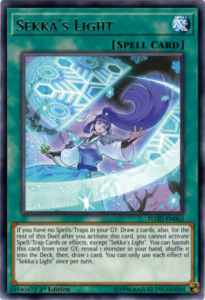 Another case of where you ask what players would do just for that “Pot of Greed” effect and Sekka’s Light is the latest card to offer that. Sekka’s Light must be activated if you have no Spells or Traps in your GY and then you get to just draw 2 cards, but with a catch. For the remainder of the duel you cannot activate any other Spells or Traps or their effects except for Sekka’s Light. Sekka’s Light also lets you banish it from the GY to reveal a monster in your hand and shuffle it into your deck to draw 1 card. Sekka’s Light is a really good draw card for monster heavy decks. I’ve seen Mermails and Burning Abyss go to playing 37 or more monsters and 3 of this card just to make use of that draw 2. This is a nice card that gave life to Monster Mash strategies just as That Grass Looks Greener gave new life to 60 card decks.
Another case of where you ask what players would do just for that “Pot of Greed” effect and Sekka’s Light is the latest card to offer that. Sekka’s Light must be activated if you have no Spells or Traps in your GY and then you get to just draw 2 cards, but with a catch. For the remainder of the duel you cannot activate any other Spells or Traps or their effects except for Sekka’s Light. Sekka’s Light also lets you banish it from the GY to reveal a monster in your hand and shuffle it into your deck to draw 1 card. Sekka’s Light is a really good draw card for monster heavy decks. I’ve seen Mermails and Burning Abyss go to playing 37 or more monsters and 3 of this card just to make use of that draw 2. This is a nice card that gave life to Monster Mash strategies just as That Grass Looks Greener gave new life to 60 card decks.
Red Reboot
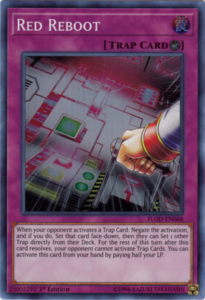 What might hurt this card is the fact that Traps aren’t as prevalent in the meta as they used to be. The only decks that really play Traps are the ones that are really centered around Traps, while other decks might just throw in a few Solemns or Infinite Impermanence in the Main Deck and some other floodgates in the Side Deck. With that said, Red Reboot is still a great Counter Trap for combo based decks. First off, what makes this card so useful is that you can pay half your LP to use it from the hand, which might sound like a big cost, but can pay off if you end up making an unbeatable board or win. Red Reboot activates when your opponent uses a Trap Card, the activation will be negated and the Trap will be set face-down again and your opponent then can set a Trap from their deck. That does sound pretty bad, but then Red Reboot makes up for it with the fact that for the rest of the turn, your opponent cannot activate Trap Cards for the rest of the turn. Red Reboot almost guarantees your plays go through as long as you can out hand traps or the occasional Quick-Play Spell or monster effect, but when making your plays, you best make sure to make them count because you did give your opponent a Trap Card to use later on.
What might hurt this card is the fact that Traps aren’t as prevalent in the meta as they used to be. The only decks that really play Traps are the ones that are really centered around Traps, while other decks might just throw in a few Solemns or Infinite Impermanence in the Main Deck and some other floodgates in the Side Deck. With that said, Red Reboot is still a great Counter Trap for combo based decks. First off, what makes this card so useful is that you can pay half your LP to use it from the hand, which might sound like a big cost, but can pay off if you end up making an unbeatable board or win. Red Reboot activates when your opponent uses a Trap Card, the activation will be negated and the Trap will be set face-down again and your opponent then can set a Trap from their deck. That does sound pretty bad, but then Red Reboot makes up for it with the fact that for the rest of the turn, your opponent cannot activate Trap Cards for the rest of the turn. Red Reboot almost guarantees your plays go through as long as you can out hand traps or the occasional Quick-Play Spell or monster effect, but when making your plays, you best make sure to make them count because you did give your opponent a Trap Card to use later on.
Waking the Dragon
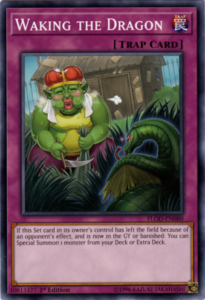 This is one of the more interesting cards of the year. Waking the Dragon is a Trap Card that really can’t be activated. All Waking the Dragon does is that while it is set and it is sent to your GY by your opponent’s card effect or is banished by your opponent, you can summon any monster from your Deck or Extra Deck, but doesn’t ignore summoning conditions so there are a few exceptions. This is a good bait card to set against your opponent if you know they like to remove your set Spells or Traps. Once they get rid of this, you can summon something like Raidraptor – Ultimate Falcon to have a 3500 body that is unaffected by card effects or The Last Warrior From Another Planet to prevent your opponent from summoning or Naturia Exterio to negate all their Spells or Traps. The card is a sitting land mine for your opponent, and it is very lethal.
This is one of the more interesting cards of the year. Waking the Dragon is a Trap Card that really can’t be activated. All Waking the Dragon does is that while it is set and it is sent to your GY by your opponent’s card effect or is banished by your opponent, you can summon any monster from your Deck or Extra Deck, but doesn’t ignore summoning conditions so there are a few exceptions. This is a good bait card to set against your opponent if you know they like to remove your set Spells or Traps. Once they get rid of this, you can summon something like Raidraptor – Ultimate Falcon to have a 3500 body that is unaffected by card effects or The Last Warrior From Another Planet to prevent your opponent from summoning or Naturia Exterio to negate all their Spells or Traps. The card is a sitting land mine for your opponent, and it is very lethal.
F.A. Dawn Dragster
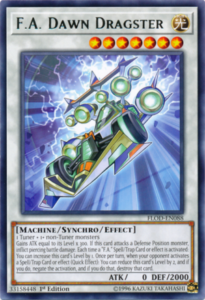 F.A. got some really good support this year, but F.A. Dawn Dragster doesn’t make this list because of what it does for F.A. as a whole. Dawn Dragster is a generic Synchro with an effect that many decks can make use of. Dawn Dragster first off gains ATK equal to its level x300 and gains 1 level if you activate an F.A. Spell/Trap or S/T effect if you are playing this in the F.A. deck. It gains piercing, which is good to have. What makes this card great is that when your opponent activates a Spell/Trap card or effect during either player’s turn, you can reduce this card’s level by two to negate the activation and destroy that card. I’ve seen this used in various different decks that set up negations and for good reason, you don’t really want to lose to cards like Raigeki or Evenly Matched. Dawn Dragster gives you more coverage with your negation at the cost of its level and some ATK points, but that doesn’t matter too much. Any deck that can make a Level 7 Synchro will likely run this because having a generic Shi En basically is very good.
F.A. got some really good support this year, but F.A. Dawn Dragster doesn’t make this list because of what it does for F.A. as a whole. Dawn Dragster is a generic Synchro with an effect that many decks can make use of. Dawn Dragster first off gains ATK equal to its level x300 and gains 1 level if you activate an F.A. Spell/Trap or S/T effect if you are playing this in the F.A. deck. It gains piercing, which is good to have. What makes this card great is that when your opponent activates a Spell/Trap card or effect during either player’s turn, you can reduce this card’s level by two to negate the activation and destroy that card. I’ve seen this used in various different decks that set up negations and for good reason, you don’t really want to lose to cards like Raigeki or Evenly Matched. Dawn Dragster gives you more coverage with your negation at the cost of its level and some ATK points, but that doesn’t matter too much. Any deck that can make a Level 7 Synchro will likely run this because having a generic Shi En basically is very good.
Sky Strikers
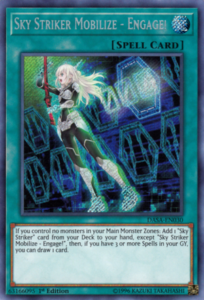 Another really good archetype, this one actually gets tops as a pure strategy or being splashed as an engine, and that’s because the cards of the archetype are just that good. We already know about Hornet Drones, since that was on the Top 11 list, but what makes that card better is being able to be searched off Sky Striker Mobilize – Engage! when you have no monsters in the Main Monster Zone (most of the Sky Striker Spells require this, except their Continuous and Field Spells) and then if you have 3 or more Spells in your GY, Engage lets you draw 1 card. Beyond that, Engage! has a ton of good Spells to search. Afterburners destroys a face-up monster and then if 3 or more Spells are in the GY, you get to destroy a Spell or Trap as well. Jamming Waves destroys a set Spell or Trap and if you have 3+ Spells in the GY, you get to destroy a monster. Vector Blast mills the top 2 cards of both decks and if you have 3+ Spells in the GY, your
Another really good archetype, this one actually gets tops as a pure strategy or being splashed as an engine, and that’s because the cards of the archetype are just that good. We already know about Hornet Drones, since that was on the Top 11 list, but what makes that card better is being able to be searched off Sky Striker Mobilize – Engage! when you have no monsters in the Main Monster Zone (most of the Sky Striker Spells require this, except their Continuous and Field Spells) and then if you have 3 or more Spells in your GY, Engage lets you draw 1 card. Beyond that, Engage! has a ton of good Spells to search. Afterburners destroys a face-up monster and then if 3 or more Spells are in the GY, you get to destroy a Spell or Trap as well. Jamming Waves destroys a set Spell or Trap and if you have 3+ Spells in the GY, you get to destroy a monster. Vector Blast mills the top 2 cards of both decks and if you have 3+ Spells in the GY, your 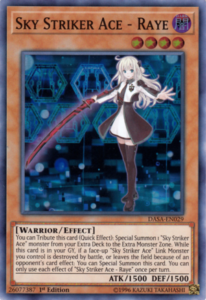 opponent’s Extra Monster Zone monsters go back into the Deck/Extra Deck. Eagle Booster makes your monster unaffected by card effects and 3+ Spells gives the monster immunity from being destroyed in battle. Shark Cannon banishes a monster in the opponent’s GY or if you have 3+ Spells in your GY you get to summon it with it being unable to attack. Widow Anchor negates a monster’s effects and then if you have 3+ Spells in the GY you get to also take control of that monster for the turn. Finally, Hercules Base lets the equipped monster get two attacks but being unable to attack directly and then when you have 3+ Spells in the GY you can draw a card when the equipped monster destroys a monster in battle but also when Hercules Base goes to the GY (no matter how many Spells there are in there) you can shuffle 3 Sky Striker cards back
opponent’s Extra Monster Zone monsters go back into the Deck/Extra Deck. Eagle Booster makes your monster unaffected by card effects and 3+ Spells gives the monster immunity from being destroyed in battle. Shark Cannon banishes a monster in the opponent’s GY or if you have 3+ Spells in your GY you get to summon it with it being unable to attack. Widow Anchor negates a monster’s effects and then if you have 3+ Spells in the GY you get to also take control of that monster for the turn. Finally, Hercules Base lets the equipped monster get two attacks but being unable to attack directly and then when you have 3+ Spells in the GY you can draw a card when the equipped monster destroys a monster in battle but also when Hercules Base goes to the GY (no matter how many Spells there are in there) you can shuffle 3 Sky Striker cards back 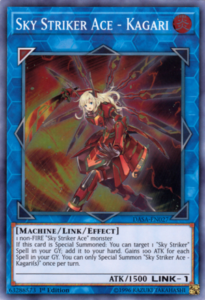 into your deck. Now I get to the Spells that don’t need 3+ Spells in the GY for anything and don’t require you to have no monsters in the Main Monster Zones. Area Zero is the Field Spell that lets you target a card you control and then excavate the top 3 cards of your deck and if there is a Sky Striker card in there, you can add one of them to your hand and shuffle the rest of the cards back into your deck whether you add a card or not, but if you do excavate a Sky Striker card you have to send the card you targeted to the GY, also Area Zero summons a Sky Striker Ace monster from your Deck when it is sent to the GY (more on that in a second). Multirole is their Continuous Spell that lets you send a card you control to the GY to prevent your opponent from responding to your Spells for the rest of the turn. Also during your End Phase you can set Sky Striker Spells from your GY with different names up to the number of Sky Striker
into your deck. Now I get to the Spells that don’t need 3+ Spells in the GY for anything and don’t require you to have no monsters in the Main Monster Zones. Area Zero is the Field Spell that lets you target a card you control and then excavate the top 3 cards of your deck and if there is a Sky Striker card in there, you can add one of them to your hand and shuffle the rest of the cards back into your deck whether you add a card or not, but if you do excavate a Sky Striker card you have to send the card you targeted to the GY, also Area Zero summons a Sky Striker Ace monster from your Deck when it is sent to the GY (more on that in a second). Multirole is their Continuous Spell that lets you send a card you control to the GY to prevent your opponent from responding to your Spells for the rest of the turn. Also during your End Phase you can set Sky Striker Spells from your GY with different names up to the number of Sky Striker 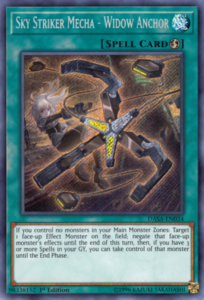 Spells you activated this turn while it was face up on the field, but the cards you set will be banished. Now for their monsters, which are all Sky Striker Ace monsters. Their only Main Deck monster is Raye, who can tribute herself to Special Summon a Sky Striker Ace Link Monster from your Extra Deck to the Extra Monster Zone and revives herself from the GY when a Sky Striker Ace Link Monster is destroyed by battle or leaves the field thanks to your opponent’s effect. The archetype had 3 Link Monsters this year and will get a fourth in 2019 and it needs to be noted you can only Special Summon each of the Link Monsters once per turn and they require a Sky Striker Ace monster except a monster of the same attribute as it. The first one is Hayate, which is the WIND Link-1, can attack directly and send a Sky Striker card from the deck to the GY after it battles. The second one is Shizuku, the WATER Link-1, that debuffs your opponent’s monsters by 100 ATK and DEF for each Spell in your GY and at the end of the turn it was summoned lets you search for a Sky Striker Spell from your deck with a different name from the ones in your GY. The final one, and the one used in the Sky Striker engine the most, is Kagari, which is the FIRE Link-1 that gains 100 ATK for each Spell in your GY and when summoned can get back any Sky Striker Spell in the GY. Sky Strikers are a very consistent archetype, which made it a good pure deck or engine, and will be relevant until the archetype takes too many heavy hits, which based on the OCG would include Hornet Drones and Kagari at 1 and Engage and Widow Anchor at 2.
Spells you activated this turn while it was face up on the field, but the cards you set will be banished. Now for their monsters, which are all Sky Striker Ace monsters. Their only Main Deck monster is Raye, who can tribute herself to Special Summon a Sky Striker Ace Link Monster from your Extra Deck to the Extra Monster Zone and revives herself from the GY when a Sky Striker Ace Link Monster is destroyed by battle or leaves the field thanks to your opponent’s effect. The archetype had 3 Link Monsters this year and will get a fourth in 2019 and it needs to be noted you can only Special Summon each of the Link Monsters once per turn and they require a Sky Striker Ace monster except a monster of the same attribute as it. The first one is Hayate, which is the WIND Link-1, can attack directly and send a Sky Striker card from the deck to the GY after it battles. The second one is Shizuku, the WATER Link-1, that debuffs your opponent’s monsters by 100 ATK and DEF for each Spell in your GY and at the end of the turn it was summoned lets you search for a Sky Striker Spell from your deck with a different name from the ones in your GY. The final one, and the one used in the Sky Striker engine the most, is Kagari, which is the FIRE Link-1 that gains 100 ATK for each Spell in your GY and when summoned can get back any Sky Striker Spell in the GY. Sky Strikers are a very consistent archetype, which made it a good pure deck or engine, and will be relevant until the archetype takes too many heavy hits, which based on the OCG would include Hornet Drones and Kagari at 1 and Engage and Widow Anchor at 2.
Number 75: Bamboozling Gossip Shadow
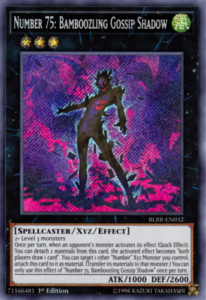 The numbers still need to be filled out cause there are supposed to be 107 of them and there are still some gaps to be filled in some voids. Here to fill one of those gaps is the Rank 3 Number 75: Bamboozling Gossip Shadow. It is a generic Rank 3 that requires any 2 or more Level 3 monsters and once per turn, Quick Effect, when your opponent activates a monster effect, you can detach 2 materials from this card to make that effect become “Both players draw 1 card”. I mean, you don’t really want to give your opponent advantage, but letting them get a blind draw is better than letting them search for something, and you get a draw as well. This can also negate some powerful effect that might lead to you losing the game. This effect is nice to have in any Rank 3 decks. Another good effect this has is that you can target another Number Xyz monster you control and attach this card and its materials to that card. The best number this is used with is Number 86 to get all of its effects for having 5 or more Xyz materials, which if you have a Number 86 with a ton of materials, you are likely going to win the game. Number 75 has seen some use in Rank 3 decks and much use in decks that are meant to turbo out Number 86, which gets it an honorable mention on this list because of how powerful that play is in the meta.
The numbers still need to be filled out cause there are supposed to be 107 of them and there are still some gaps to be filled in some voids. Here to fill one of those gaps is the Rank 3 Number 75: Bamboozling Gossip Shadow. It is a generic Rank 3 that requires any 2 or more Level 3 monsters and once per turn, Quick Effect, when your opponent activates a monster effect, you can detach 2 materials from this card to make that effect become “Both players draw 1 card”. I mean, you don’t really want to give your opponent advantage, but letting them get a blind draw is better than letting them search for something, and you get a draw as well. This can also negate some powerful effect that might lead to you losing the game. This effect is nice to have in any Rank 3 decks. Another good effect this has is that you can target another Number Xyz monster you control and attach this card and its materials to that card. The best number this is used with is Number 86 to get all of its effects for having 5 or more Xyz materials, which if you have a Number 86 with a ton of materials, you are likely going to win the game. Number 75 has seen some use in Rank 3 decks and much use in decks that are meant to turbo out Number 86, which gets it an honorable mention on this list because of how powerful that play is in the meta.
Number 90: Galaxy-Eyes Photon Lord
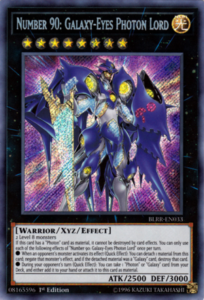 It seems all the Rank 8 Galaxy monsters are pretty good and this one is no exception. Number 90 is a generic Rank 8 only needing 2 Level 8 monsters and gives many Rank 8 decks something it lacked from the Extra Deck, monster effect negation. Sure Felgrand could also negate monsters, but you’d sometimes want to use that to protect your monster’s from effects as well, so Photon Lord can be dedicated to negating monster effects, and all you need to do is detach 1 Xyz material, though it is a once per turn effect. A nice thing about this card is that while it is good in Level 8 spam decks, you get extra benefits if you play this with Photon/Galaxy cards. One of those benefits include protection from effect destruction while it has a Photon monster as material. Also with the monster negation effect, if detached a Galaxy card as material for said effect, you can destroy the monster you negated. Also during your opponent’s turn this card can take any Photon/Galaxy card from your deck and either add it to your hand or add it to this card as Xyz material so you don’t run out of monster negation. Being a good generic Rank 8 makes this worthy of a top card for the year, cause you never know when Rank 8s will be meta relevant, but it is also nice that this card is designed to where it benefits its archetype more.
It seems all the Rank 8 Galaxy monsters are pretty good and this one is no exception. Number 90 is a generic Rank 8 only needing 2 Level 8 monsters and gives many Rank 8 decks something it lacked from the Extra Deck, monster effect negation. Sure Felgrand could also negate monsters, but you’d sometimes want to use that to protect your monster’s from effects as well, so Photon Lord can be dedicated to negating monster effects, and all you need to do is detach 1 Xyz material, though it is a once per turn effect. A nice thing about this card is that while it is good in Level 8 spam decks, you get extra benefits if you play this with Photon/Galaxy cards. One of those benefits include protection from effect destruction while it has a Photon monster as material. Also with the monster negation effect, if detached a Galaxy card as material for said effect, you can destroy the monster you negated. Also during your opponent’s turn this card can take any Photon/Galaxy card from your deck and either add it to your hand or add it to this card as Xyz material so you don’t run out of monster negation. Being a good generic Rank 8 makes this worthy of a top card for the year, cause you never know when Rank 8s will be meta relevant, but it is also nice that this card is designed to where it benefits its archetype more.
Topologic Gumblar Dragon
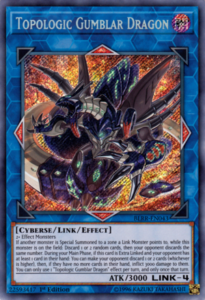 Probably the biggest exemption from the Top 11 list, Gumblar Dragon is one of the latest Link Monsters that players have been asking to be banned. Gumblar is a Link-4 that requires any 2+ Effect monsters as materials and arrows that make it usable in the Extra Monster Zone, but are much better in the Main Monster Zone so it doesn’t give your opponent an arrow. Gumblar has a powerful effect that if a monster is Special Summoned to a zone a Link Monster points to, then you discard 1 or 2 cards from your hand to make your opponent discard the same amount of cards if they are able to. Now, this is a mandatory effect, but if you play your cards right, then you’ll mostly be using this only when you want to trigger it. Even if your opponent is out of cards in their hand, then when this triggers if you or potentially your opponent summons a monster to a zone any Link Monster points to, you can just discard 1 card to soften the blow. This is used in combos that can trigger it on your turn and then your opponent’s first turn to take four cards from their hand and leave them starting with 2 while you generated a ton of hand and field advantage. Even if your opponent chooses what they discard, they still lost two-thirds of their hand. Gumblar also has another niche effect that if it is Extra Linked and your opponent has at least 1 card in their hand, you can make your opponent discard 1 or 2 cards, depending on if they can only discard 1 or if they are able to discard 2, and then if their hand is empty, they get dealt with 3000 points of damage. It isn’t often that this happens, but you never know when you’ll need to keep eating your opponent’s hand and this card is Extra Linked. You only get 1 Gumblar effect per turn so you can’t destroy your opponent’s hand by 4 cards in one turn and then somehow trigger it on their turn to completely empty their hand. The matter of fact still is that this destroys a majority of your opponent’s hand before they really begin to play, so I can see why this is banworthy to many and how it deserves an honorable mention here.
Probably the biggest exemption from the Top 11 list, Gumblar Dragon is one of the latest Link Monsters that players have been asking to be banned. Gumblar is a Link-4 that requires any 2+ Effect monsters as materials and arrows that make it usable in the Extra Monster Zone, but are much better in the Main Monster Zone so it doesn’t give your opponent an arrow. Gumblar has a powerful effect that if a monster is Special Summoned to a zone a Link Monster points to, then you discard 1 or 2 cards from your hand to make your opponent discard the same amount of cards if they are able to. Now, this is a mandatory effect, but if you play your cards right, then you’ll mostly be using this only when you want to trigger it. Even if your opponent is out of cards in their hand, then when this triggers if you or potentially your opponent summons a monster to a zone any Link Monster points to, you can just discard 1 card to soften the blow. This is used in combos that can trigger it on your turn and then your opponent’s first turn to take four cards from their hand and leave them starting with 2 while you generated a ton of hand and field advantage. Even if your opponent chooses what they discard, they still lost two-thirds of their hand. Gumblar also has another niche effect that if it is Extra Linked and your opponent has at least 1 card in their hand, you can make your opponent discard 1 or 2 cards, depending on if they can only discard 1 or if they are able to discard 2, and then if their hand is empty, they get dealt with 3000 points of damage. It isn’t often that this happens, but you never know when you’ll need to keep eating your opponent’s hand and this card is Extra Linked. You only get 1 Gumblar effect per turn so you can’t destroy your opponent’s hand by 4 cards in one turn and then somehow trigger it on their turn to completely empty their hand. The matter of fact still is that this destroys a majority of your opponent’s hand before they really begin to play, so I can see why this is banworthy to many and how it deserves an honorable mention here.
Impcantations
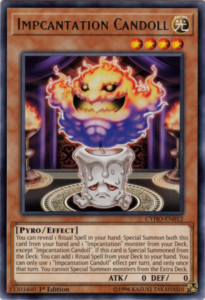 Considering these cards here gave Rituals a new lease on life, they are really worthy of an honorable mention due to how good they are in Ritual decks and the future potential they give to said decks. So far the archetype has four monsters and will get some Ritual Monsters and Spells in 2019, but I won’t talk about those here. Their first two cards were Impcantation Candoll and Talismandra and later we got Bookstone and Pencilplume. Candoll and Bookstone could be summoned by revealing a Ritual Spell in your hand while Talismandra and Pencilplume were summoned by revealing a Ritual Monster in your hand, and if you summon them by
Considering these cards here gave Rituals a new lease on life, they are really worthy of an honorable mention due to how good they are in Ritual decks and the future potential they give to said decks. So far the archetype has four monsters and will get some Ritual Monsters and Spells in 2019, but I won’t talk about those here. Their first two cards were Impcantation Candoll and Talismandra and later we got Bookstone and Pencilplume. Candoll and Bookstone could be summoned by revealing a Ritual Spell in your hand while Talismandra and Pencilplume were summoned by revealing a Ritual Monster in your hand, and if you summon them by 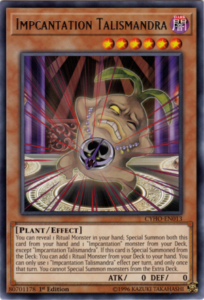 revealing said Ritual related card, you also summoned another Impcantation from your deck. This helps get you to some levels to add up for a Ritual Summon, but when the Impcantations were summoned from the deck, they also got you to Ritual cards. Candoll when summoned from the deck searched a Ritual Monster from your deck to your hand, Talismandra searched for a Ritual Spell out of your deck, Bookstone got a Ritual Spell from your GY back, and Pencilplume got a Ritual Monster out of your GY. These four monsters along with their future support really help Ritual based decks gain a ton of card advantage, which is something they need since they sacrifice monsters for Ritual Summons along with requiring a Ritual Spell. These cards add a ton of consistency to Ritual decks and even if they haven’t made an meta impact yet, the power these cards offer to Rituals is too good to not mention them.
revealing said Ritual related card, you also summoned another Impcantation from your deck. This helps get you to some levels to add up for a Ritual Summon, but when the Impcantations were summoned from the deck, they also got you to Ritual cards. Candoll when summoned from the deck searched a Ritual Monster from your deck to your hand, Talismandra searched for a Ritual Spell out of your deck, Bookstone got a Ritual Spell from your GY back, and Pencilplume got a Ritual Monster out of your GY. These four monsters along with their future support really help Ritual based decks gain a ton of card advantage, which is something they need since they sacrifice monsters for Ritual Summons along with requiring a Ritual Spell. These cards add a ton of consistency to Ritual decks and even if they haven’t made an meta impact yet, the power these cards offer to Rituals is too good to not mention them.
Danger!
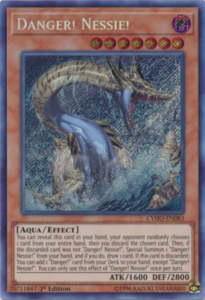 After a year of Vendreads and F.A.s being our TCG exclusive archetypes, we had to move forward and have some new TCG exclusive cards and for the first time since SPYRALs, we got a meta relevant TCG archetype in the Danger! archetype. Now each of the Danger! monsters can reveal themselves in the hand and then go back to the hand so your opponent has to pick a card in your hand at random to discard, and if they don’t discard a Danger! monster with the same name as the one you revealed, you can summon the Danger! you first revealed and draw 1 card, and none of those are hard once per turn effects. What are hard once per turn effects are the effects they get when discarded, whether off their own
After a year of Vendreads and F.A.s being our TCG exclusive archetypes, we had to move forward and have some new TCG exclusive cards and for the first time since SPYRALs, we got a meta relevant TCG archetype in the Danger! archetype. Now each of the Danger! monsters can reveal themselves in the hand and then go back to the hand so your opponent has to pick a card in your hand at random to discard, and if they don’t discard a Danger! monster with the same name as the one you revealed, you can summon the Danger! you first revealed and draw 1 card, and none of those are hard once per turn effects. What are hard once per turn effects are the effects they get when discarded, whether off their own 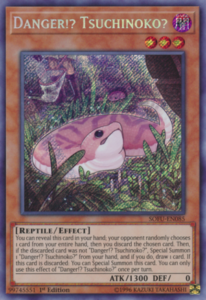 effect, another Danger! effect, or something else, and I’ll mention some of the better Danger! discard effects. Bigfoot! and Thunderbird! are your board clearing cards as Bigfoot! destroys a face-up card while Thunderbird! destroys a set card. Nessie! is your standard searcher for the archetype, as it searches anything but itself from the deck. Jackalope? summons any Danger! out of your deck excluding itself. Chupacabra! revives any Danger! from your GY except itself. Finally, Tsuchinoko? revives itself from the GY, basically guaranteeing its summon if you reveal it. They got their own Graceful Charity in Trap form with Danger! Zone which does the draw 3 and discard 2, but you got to discard a Danger! otherwise your hand goes into the deck. Danger! Response Team lets you bounce a Danger! monster and any other monster on the field to the hand and while in the GY will let you discard a Danger! to put this card back on the bottom and draw 1 card. The Danger! archetype has several other cards, but those cards mentioned were probably the most noteworthy.
effect, another Danger! effect, or something else, and I’ll mention some of the better Danger! discard effects. Bigfoot! and Thunderbird! are your board clearing cards as Bigfoot! destroys a face-up card while Thunderbird! destroys a set card. Nessie! is your standard searcher for the archetype, as it searches anything but itself from the deck. Jackalope? summons any Danger! out of your deck excluding itself. Chupacabra! revives any Danger! from your GY except itself. Finally, Tsuchinoko? revives itself from the GY, basically guaranteeing its summon if you reveal it. They got their own Graceful Charity in Trap form with Danger! Zone which does the draw 3 and discard 2, but you got to discard a Danger! otherwise your hand goes into the deck. Danger! Response Team lets you bounce a Danger! monster and any other monster on the field to the hand and while in the GY will let you discard a Danger! to put this card back on the bottom and draw 1 card. The Danger! archetype has several other cards, but those cards mentioned were probably the most noteworthy.
Outer Entity Azathot
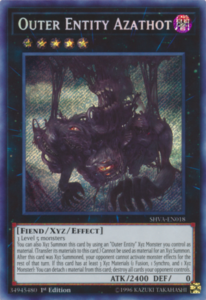 It took over three years for the TCG to get this card along with some of the other Entity cards to complete the series, but this card still made an impact when being released three years after its initial debut overseas. Outer Entity Azathot might be a generic Rank 3 that needs three Level 5 monsters, but you are likely using this with Outer Entity Nyarla since it can also be summoned over an Outer Entity Xyz monster, or via some Rank-Up-Magic that can summon this on your opponent’s turn. Azathot itself cannot be used as material for an Xyz Summon, but I don’t know when or if that’ll ever matter. After Azathot is Xyz Summoned, your opponent cannot activate monster effects for the rest of the turn, which made this card good with FTK strategies so they didn’t get hand trapped, or in some Rank-Up decks using a Quick-Play Rank-Up to summon this on the opponent’s turn to basically have a Shock Master for monsters on their turn. The other effect of this card was clearly meant for Norden being around as if this card has a Fusion, Synchro, and Xyz as material, you can detach a material to destroy all cards your opponent controls. This effect will be more useful if/when Norden comes back, so remember that this card has an ability like this, cause it’ll probably lock your monster effects down before it destroys everything you have, you just need to find a good Level 4 Synchro to work with this.
It took over three years for the TCG to get this card along with some of the other Entity cards to complete the series, but this card still made an impact when being released three years after its initial debut overseas. Outer Entity Azathot might be a generic Rank 3 that needs three Level 5 monsters, but you are likely using this with Outer Entity Nyarla since it can also be summoned over an Outer Entity Xyz monster, or via some Rank-Up-Magic that can summon this on your opponent’s turn. Azathot itself cannot be used as material for an Xyz Summon, but I don’t know when or if that’ll ever matter. After Azathot is Xyz Summoned, your opponent cannot activate monster effects for the rest of the turn, which made this card good with FTK strategies so they didn’t get hand trapped, or in some Rank-Up decks using a Quick-Play Rank-Up to summon this on the opponent’s turn to basically have a Shock Master for monsters on their turn. The other effect of this card was clearly meant for Norden being around as if this card has a Fusion, Synchro, and Xyz as material, you can detach a material to destroy all cards your opponent controls. This effect will be more useful if/when Norden comes back, so remember that this card has an ability like this, cause it’ll probably lock your monster effects down before it destroys everything you have, you just need to find a good Level 4 Synchro to work with this.
Aleister the Invoker of Madness
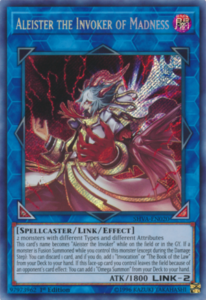 The most recent Link Vrains Pack 1 Link Monster we got, Alesiter the Invoker of Madness makes the Invoked engine much better than it originally was. The summoning requirements are 2 monsters with different types and attributes, basically since every Invoked Fusion has a different type and attribute, and comes with Bottom Left and Bottom Right arrows to really make use of the Invoked cards. This card’s name is treated as Aleister the Invoker while on the field or in the GY to make it more useful with Invocation. If a monster is Fusion Summoned while you control this card, then you can discard 1 card to add 1 Invocation or The Book of the Law from your deck to your hand to add more consistency with your Invoked cards while giving The Book of the Law more use since it is now searchable. If your opponent also gets rid of this via a card effect, you can search for 1 Omega Summon. Now sure, Omega Summon still isn’t a popular card to play, but your opponent might still want to think about it before using a card effect to get rid of it, though 1800 ATK and no real protection on its own shouldn’t be hard to kill in battle. Aleister is a really good card with the Invoked engine, which was already pretty good, so it deserves a mention here.
The most recent Link Vrains Pack 1 Link Monster we got, Alesiter the Invoker of Madness makes the Invoked engine much better than it originally was. The summoning requirements are 2 monsters with different types and attributes, basically since every Invoked Fusion has a different type and attribute, and comes with Bottom Left and Bottom Right arrows to really make use of the Invoked cards. This card’s name is treated as Aleister the Invoker while on the field or in the GY to make it more useful with Invocation. If a monster is Fusion Summoned while you control this card, then you can discard 1 card to add 1 Invocation or The Book of the Law from your deck to your hand to add more consistency with your Invoked cards while giving The Book of the Law more use since it is now searchable. If your opponent also gets rid of this via a card effect, you can search for 1 Omega Summon. Now sure, Omega Summon still isn’t a popular card to play, but your opponent might still want to think about it before using a card effect to get rid of it, though 1800 ATK and no real protection on its own shouldn’t be hard to kill in battle. Aleister is a really good card with the Invoked engine, which was already pretty good, so it deserves a mention here.
Dinowrestler Pankratops
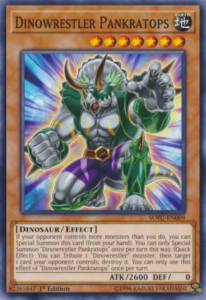 I did mention with Overtex how Dinosaurs did get more support somewhat with Dinowrestlers, and while Pankratops might be really good in Dinosaurs since they can search for it, Pnakratops makes this article for just being a good card to throw into any Side or Main Deck. First off, Pankratops can be Special Summoned from your hand once per turn if your opponent controls more monsters than you do, meaning you can get a very easy 2600 ATK Level 7 on board. Also Pankratops has a Quick Effect that is a hard once per turn where it can tribute any Dinowrestler monster, including itself, to target and destroy any card your opponent controls. Being able to destroy any card is good and Pankratops is not limiting at all to being able to destroy any of your opponent’s cards except on what kind of monster you have to tribute, but it thankfully fits the requirement by itself so you wouldn’t have to run other Dinowrestlers in a deck where they wouldn’t fit in with. Pankratops is easily one of the best Side Deck cards printed this year, because using this going second can be pretty good.
I did mention with Overtex how Dinosaurs did get more support somewhat with Dinowrestlers, and while Pankratops might be really good in Dinosaurs since they can search for it, Pnakratops makes this article for just being a good card to throw into any Side or Main Deck. First off, Pankratops can be Special Summoned from your hand once per turn if your opponent controls more monsters than you do, meaning you can get a very easy 2600 ATK Level 7 on board. Also Pankratops has a Quick Effect that is a hard once per turn where it can tribute any Dinowrestler monster, including itself, to target and destroy any card your opponent controls. Being able to destroy any card is good and Pankratops is not limiting at all to being able to destroy any of your opponent’s cards except on what kind of monster you have to tribute, but it thankfully fits the requirement by itself so you wouldn’t have to run other Dinowrestlers in a deck where they wouldn’t fit in with. Pankratops is easily one of the best Side Deck cards printed this year, because using this going second can be pretty good.
Thunder Dragons
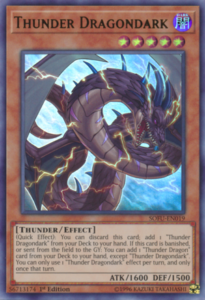 The two Fusion monsters they got did make the countdown, but that was helped by the fact that the Thunder Dragon archetype as a whole is really good. Each of the Thunder Dragon monsters that got printed this year, outside the two Fusions and their Chaos Monster, have effects to be discarded from the hand and when they are banished or sent from the field to the GY, balanced by the fact that you can only use 1 effect per turn for each of them. Dragonmatrix is a Quick Effect to discard to boost a Thunder by 500 ATK to help trigger Titan as well as banishing or sending Dragonmatrix from the field to the GY gets you another Dragonmatrix. Dragondark discards to search another Dragondark as a Quick Effect and its other effect for being banished or sent from the field to the GY searches for any Thunder Dragon card. Dragonhawk discards itself to Special Summon a Thunder Dragon that is banished or in your GY and when banished or sent from the field to the GY can let you send any cards in
The two Fusion monsters they got did make the countdown, but that was helped by the fact that the Thunder Dragon archetype as a whole is really good. Each of the Thunder Dragon monsters that got printed this year, outside the two Fusions and their Chaos Monster, have effects to be discarded from the hand and when they are banished or sent from the field to the GY, balanced by the fact that you can only use 1 effect per turn for each of them. Dragonmatrix is a Quick Effect to discard to boost a Thunder by 500 ATK to help trigger Titan as well as banishing or sending Dragonmatrix from the field to the GY gets you another Dragonmatrix. Dragondark discards to search another Dragondark as a Quick Effect and its other effect for being banished or sent from the field to the GY searches for any Thunder Dragon card. Dragonhawk discards itself to Special Summon a Thunder Dragon that is banished or in your GY and when banished or sent from the field to the GY can let you send any cards in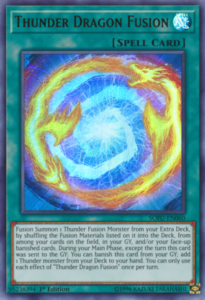 your hand back to the deck to draw the same number. Finally for the discard/banish Thunder Dragons, Dragonroar discards himself to add back a Thunder Dragon that is banished or in your GY and when banished or sent from the field to the GY can summon any Thunder Dragon from your deck, except Dragonduo because of its summoning condition, but said Thunder Dragon goes back to your hand at the end of the turn it was summoned. The aforementioned Chaos Monster, Thunder Dragonduo, is summoned like any other Chaos Monster by banishing a LIGHT and DARK from your GY, gains 300 ATK for the turn when you use an effect in your hand, searches for a Thunder monster by banishing a card in your GY after it destroys a monster in battle, and finally can take one of your banished cards and send it back to the top or bottom of your deck. Their best Spell is Thunder Dragon Fusion, which can use your banished, GY, or field monsters for the Fusion Summon of a Thunder Fusion and can banish itself from your GY on a later turn to search for any Thunder monster. This archetype works well with many cards from the past, as well as some cards released this year like Chaos Dragon Levianeer, Batteryman Solar, and Some Summer Summoner. The archetype as a whole is really good, and basically what helped get the Thunder Dragon Fusions on the list to begin with.
your hand back to the deck to draw the same number. Finally for the discard/banish Thunder Dragons, Dragonroar discards himself to add back a Thunder Dragon that is banished or in your GY and when banished or sent from the field to the GY can summon any Thunder Dragon from your deck, except Dragonduo because of its summoning condition, but said Thunder Dragon goes back to your hand at the end of the turn it was summoned. The aforementioned Chaos Monster, Thunder Dragonduo, is summoned like any other Chaos Monster by banishing a LIGHT and DARK from your GY, gains 300 ATK for the turn when you use an effect in your hand, searches for a Thunder monster by banishing a card in your GY after it destroys a monster in battle, and finally can take one of your banished cards and send it back to the top or bottom of your deck. Their best Spell is Thunder Dragon Fusion, which can use your banished, GY, or field monsters for the Fusion Summon of a Thunder Fusion and can banish itself from your GY on a later turn to search for any Thunder monster. This archetype works well with many cards from the past, as well as some cards released this year like Chaos Dragon Levianeer, Batteryman Solar, and Some Summer Summoner. The archetype as a whole is really good, and basically what helped get the Thunder Dragon Fusions on the list to begin with.
Trap Trick
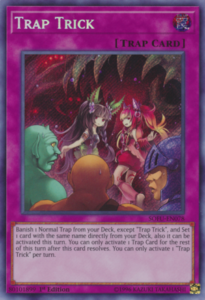 Traps are not as good as they once were, but there are still decks that make use of Trap cards, as well as decks dedicated to them, and Trap Trick was a great piece of support for those kinds of decks. Trap Trick is a Normal Trap that banished any other Normal Trap from your deck to set a card with the same name from your deck, but after you use this effect you can only activate 1 more Trap card for that turn. This can be useful in several Trap decks like Paleozoics or maybe Altergeists to get to some very powerful Normal Traps to extend your plays and/or disrupt your opponent. The game is still full of great generic Trap cards as well, Torrential Tribute comes to mind. As well as the game having some Trap cards that can be good in specific decks and Trap Trick helps you see those cards more consistently basically, almost like you are running 6 of a specific Normal Trap. As long as the game has good Normal Traps at three, Trap Trick is going to be a good card.
Traps are not as good as they once were, but there are still decks that make use of Trap cards, as well as decks dedicated to them, and Trap Trick was a great piece of support for those kinds of decks. Trap Trick is a Normal Trap that banished any other Normal Trap from your deck to set a card with the same name from your deck, but after you use this effect you can only activate 1 more Trap card for that turn. This can be useful in several Trap decks like Paleozoics or maybe Altergeists to get to some very powerful Normal Traps to extend your plays and/or disrupt your opponent. The game is still full of great generic Trap cards as well, Torrential Tribute comes to mind. As well as the game having some Trap cards that can be good in specific decks and Trap Trick helps you see those cards more consistently basically, almost like you are running 6 of a specific Normal Trap. As long as the game has good Normal Traps at three, Trap Trick is going to be a good card.
Doomking Balerdroch (and other Zombies)
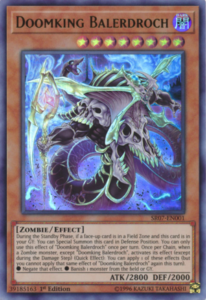 The Zombie Structure Deck was really good as it helped make the Zombie deck even more competitive than it already was, though maybe not a top tier deck. The card that probably stood out the most was Doomking Balerdroch. Balerdroch could revive itself from the GY in Defense Position during either Standby Phase just as long as you controlled a card face-up in your Field Zone. Doomking also had two effects you could use once per turn each when a Zombie monster activated its effect. Those effects were to negate that Zombie monster’s effect as well as to banish any monster from the field or GY. This works well in tandem with Zombie World, which got its own dedicated searcher in
The Zombie Structure Deck was really good as it helped make the Zombie deck even more competitive than it already was, though maybe not a top tier deck. The card that probably stood out the most was Doomking Balerdroch. Balerdroch could revive itself from the GY in Defense Position during either Standby Phase just as long as you controlled a card face-up in your Field Zone. Doomking also had two effects you could use once per turn each when a Zombie monster activated its effect. Those effects were to negate that Zombie monster’s effect as well as to banish any monster from the field or GY. This works well in tandem with Zombie World, which got its own dedicated searcher in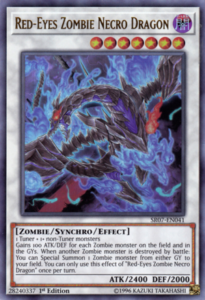 Necroworld Banshee that can just activate Zombie World from your deck or GY by banishing itself from the field or GY to get around Ash Blossom. Zombie World on the field also lets Glow-Up Bloom summon this from the deck when Bloom itself is sent to the GY just by banishing the Bloom. There are also some other good cards that work well with Zombie World like Zombie Necronize, which is basically a Change of Heart for Zombies as well as reset itself from the GY by shuffling a Zombie from your GY into your deck. Zombies also got a new Synchro in Red-Eyes Zombie Necro Dragon, which is a generic Synchro that gets stronger with more Zombies on the field or in the GYs and when a Zombie is destroyed by battle once per turn, Zombie Necro Dragon lets you revive any Zombie from either GY to your field. This is some really good support for Zombies and they stay on the cusp of becoming a Tier 1 deck potentially, cause they already have a ton of great cards.
Necroworld Banshee that can just activate Zombie World from your deck or GY by banishing itself from the field or GY to get around Ash Blossom. Zombie World on the field also lets Glow-Up Bloom summon this from the deck when Bloom itself is sent to the GY just by banishing the Bloom. There are also some other good cards that work well with Zombie World like Zombie Necronize, which is basically a Change of Heart for Zombies as well as reset itself from the GY by shuffling a Zombie from your GY into your deck. Zombies also got a new Synchro in Red-Eyes Zombie Necro Dragon, which is a generic Synchro that gets stronger with more Zombies on the field or in the GYs and when a Zombie is destroyed by battle once per turn, Zombie Necro Dragon lets you revive any Zombie from either GY to your field. This is some really good support for Zombies and they stay on the cusp of becoming a Tier 1 deck potentially, cause they already have a ton of great cards.
Prank-Kids
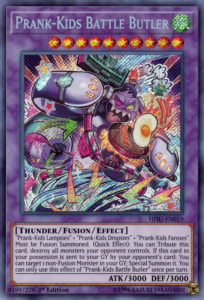 To end this all off, we have the archetype that shocked the world at YCS Milan by winning the whole thing, Prank-Kids. Prank-Kids is a good Fusion and Link Spam archetype that can get good field presence as well as summon very disruptive cards. The main deck monsters all float into different Prank-Kids monsters when used for a Fusion/Link summon by doing different things first. Fansies sends a Prank-Kids card from your deck to the GY, Dropsies lets you gain 1000 LP, Lampsies burns the opponent for 500 damage, and Rocksies lets you banish a card in your hand to draw a card. They also have two Fusion Monsters and two Link-2s that require two Prank-Kids as materials. The first fusion is Rocket Ride, which can lose 1000 ATK for the turn to attack directly for the turn it is Fusion Summoned and on your turn can be tributed to revive any
To end this all off, we have the archetype that shocked the world at YCS Milan by winning the whole thing, Prank-Kids. Prank-Kids is a good Fusion and Link Spam archetype that can get good field presence as well as summon very disruptive cards. The main deck monsters all float into different Prank-Kids monsters when used for a Fusion/Link summon by doing different things first. Fansies sends a Prank-Kids card from your deck to the GY, Dropsies lets you gain 1000 LP, Lampsies burns the opponent for 500 damage, and Rocksies lets you banish a card in your hand to draw a card. They also have two Fusion Monsters and two Link-2s that require two Prank-Kids as materials. The first fusion is Rocket Ride, which can lose 1000 ATK for the turn to attack directly for the turn it is Fusion Summoned and on your turn can be tributed to revive any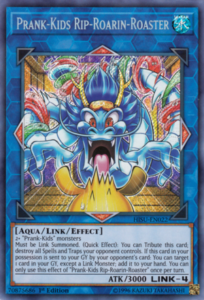 two non-Fusion Prank-Kids monsters that cannot attack that turn but can be used for another Fusion or Link Summon, and it is an Instant Fusion target to basically turn it into an Infernity Launcher. Prank-Kids Weather Washer is another Instant Fusion target, but not really an Infernity Launcher so it isn’t summoned off Instant Fusion as much, but prevents your opponent from using cards or effects when a Prank-Kids monster attacks and on your opponent’s turn can tribute itself to revive any two Prank-Kids non-Fusion monsters and give them protection from being destroyed in battle that turn. The first Link-2 is Dodo-Doodle-Doo, which on Link Summon searches for a Prank-Kids Spell/Trap and can tribute itself on your turn to add back any two non-Link Prank-Kids
two non-Fusion Prank-Kids monsters that cannot attack that turn but can be used for another Fusion or Link Summon, and it is an Instant Fusion target to basically turn it into an Infernity Launcher. Prank-Kids Weather Washer is another Instant Fusion target, but not really an Infernity Launcher so it isn’t summoned off Instant Fusion as much, but prevents your opponent from using cards or effects when a Prank-Kids monster attacks and on your opponent’s turn can tribute itself to revive any two Prank-Kids non-Fusion monsters and give them protection from being destroyed in battle that turn. The first Link-2 is Dodo-Doodle-Doo, which on Link Summon searches for a Prank-Kids Spell/Trap and can tribute itself on your turn to add back any two non-Link Prank-Kids 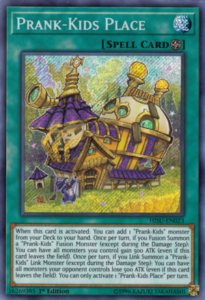 cards with different names. The other Link-2 is Bow-Wow-Bark, which gives Prank-Kids monsters it points to 1000 ATK and can be tributed on the opponent’s turn to also add back any two non-Link Prank-Kids cards with different names back to your hand as well as giving the Prank-Kids monsters you control protection from destruction via card effects. The big disruption the archetype has comes from it’s big Fusion and Link-4. Battle Butler is a Fusion of specifically Fansies, Dropsies, and Lampsies, must be Fusion Summoned, and can tribute itself on either player’s turn for a Raigeki effect, as well as if your opponent gets rid of it before you use the Raigeki effect, you can revive any non-Fusion monster in your GY. Rip-Roarin-Roaster is their Link-4 of any 2+ Prank-Kids monsters, must be Link Summoned, can tribute itself as a Quick Effect for a Harpie’s Feather Duster effect, and once again if your opponent gets rid of it before you tribute it
cards with different names. The other Link-2 is Bow-Wow-Bark, which gives Prank-Kids monsters it points to 1000 ATK and can be tributed on the opponent’s turn to also add back any two non-Link Prank-Kids cards with different names back to your hand as well as giving the Prank-Kids monsters you control protection from destruction via card effects. The big disruption the archetype has comes from it’s big Fusion and Link-4. Battle Butler is a Fusion of specifically Fansies, Dropsies, and Lampsies, must be Fusion Summoned, and can tribute itself on either player’s turn for a Raigeki effect, as well as if your opponent gets rid of it before you use the Raigeki effect, you can revive any non-Fusion monster in your GY. Rip-Roarin-Roaster is their Link-4 of any 2+ Prank-Kids monsters, must be Link Summoned, can tribute itself as a Quick Effect for a Harpie’s Feather Duster effect, and once again if your opponent gets rid of it before you tribute it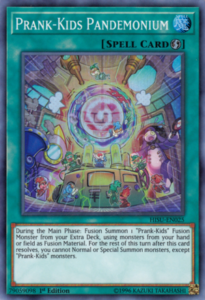 then you can add back any non-Link card from your GY to your hand. The archetype has a ton of good Spell/Trap support. Prank-Kids Pandemonium is a Quick-Play Fusion Spell for the archetype that only lets you summon Prank-Kids after you use it and must be used in the Main Phase. Prank-Kids Place is the Field Spell that searches for any Prank-Kids monster, once per turn gives all your monsters 500 ATK if you Fusion Summon a Prank-Kids monster, and once per turn deducts your opponent’s monsters by 500 ATK if you Link Summon a Prank-Kids monster. Prank-Kids Pranks is a Continuous Spell that lets you discard a Prank-Kids card to summon a Prank-Kids Token and during your End Phase lets you shuffle back three Prank-Kids cards in your GY to the deck except another Prank-Kids Pranks to then draw 1 card. Finally, Prank-Kids Plan is a Continuous Trap that lets you Link Summon a Prank-Kids on either player’s Main Phase and can banish itself from the GY to shuffle back into your deck any Prank-Kids cards in your GY when your opponent attacks to then deduct the attacking monster by 100 ATK for each card that went back into your deck. The archetype is very well rounded and can summon their Fusions and Links with great ease, as well as having four floaters in one turn, so it is a deck with strong potential in this meta and can potentially be the best deck with more support, it already won a YCS, so it is clearly capable.
then you can add back any non-Link card from your GY to your hand. The archetype has a ton of good Spell/Trap support. Prank-Kids Pandemonium is a Quick-Play Fusion Spell for the archetype that only lets you summon Prank-Kids after you use it and must be used in the Main Phase. Prank-Kids Place is the Field Spell that searches for any Prank-Kids monster, once per turn gives all your monsters 500 ATK if you Fusion Summon a Prank-Kids monster, and once per turn deducts your opponent’s monsters by 500 ATK if you Link Summon a Prank-Kids monster. Prank-Kids Pranks is a Continuous Spell that lets you discard a Prank-Kids card to summon a Prank-Kids Token and during your End Phase lets you shuffle back three Prank-Kids cards in your GY to the deck except another Prank-Kids Pranks to then draw 1 card. Finally, Prank-Kids Plan is a Continuous Trap that lets you Link Summon a Prank-Kids on either player’s Main Phase and can banish itself from the GY to shuffle back into your deck any Prank-Kids cards in your GY when your opponent attacks to then deduct the attacking monster by 100 ATK for each card that went back into your deck. The archetype is very well rounded and can summon their Fusions and Links with great ease, as well as having four floaters in one turn, so it is a deck with strong potential in this meta and can potentially be the best deck with more support, it already won a YCS, so it is clearly capable.
In Conclusion
I do like a ton of the cards released this year. It might of been a rough year with FTKs and Extra Linking, especially thanks to Firewall, and now it seems Gumblar is annoying people by taking their hands away, but beyond that I do like a ton of cards and archetypes from this year, especially those I didn’t mention cause I tried to keep this article to the most meta relevant stuff. But on this list, I enjoy Mekk-Knights, Cyber Dragons, and Prank-Kids, I kinda enjoy the Danger! monsters and how they can be used with many different strategies, Thunder Dragons are enjoyable for me to be honest, and there are a ton of useful cards to be used in various different decks. Also I kinda like the Knightmares for helping me Link Climb, open up some Monster Zones for Extra Deck plays, and getting rid of some of the opponent’s cards. This wasn’t a bad year in general, just for the meta maybe.
Thanks for Reading,
Crunch$G

